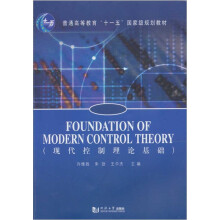现代控制理论基础

目 录内容简介
Section I State Space Analysis and Synthesis of Linear Systems
1 State Space Description of Dynamic Systems
1.1 Introduction
1.2 State and state space
1.3 State space description of dynamic systems
1.4 Canonical form of SISO state space representation
1.4.1 Controllable canonical form
1.4.2 Observable canonical form
1.4.3 Diagonal form and Jordan canonical form
1.5 Some examples of developing state space descriptions
1.6 Equivalent state equations
1.6.1 Similarity transformation
1.6.2 An application of similarity transformation Diagonal form and Jordan form
1.7 Relationship between I/O description and state-space description
1.7.1 Transfer function from state-space description
1.7.2 State-space representations from transfer functions Realizations Problems Solution of State Equations of Linear Systems
2.1 Introduction
2.2 Solution of linear homogeneous state equation
2.3 Properties and calculations of the matrix exponential function
2.3.1 Properties of e
2.3.2 Calculation of e
2.4 Solution of state equations
2.5 State transition matrix of linear time-invariant systems Problems Controllability and Observability
3.1 Introduction
3.2 Controllability
3 2 1 Definition of complete state controllability
3.2.2 Controllability criterion for time-invariant systems with arbitrary eigenvalues
3 2.3 Controllability criterion for time-invariant systems with distinct eigenvalues
3.2.4 Controllability criterions for time-invariant systems with multi-eigenvalues
3.3 Observability
3 3.1 Definition of complete state observability
3.3 2 Observability criterion for time-invariant systems with arbitrary eigenvalues
3.3.3 Observability criterion for time-invariant systems with distinct eigenvalues
3.3.4 Observability criterion for time-invariant systems with multi-eigenvalues
3.4 Principle of duality
3.5 Obtaining the controllable and observable canonical forms for SISO systems
3.5.1 Controllable canonical form of SISO systems
3.5 2 Observable canonical form of SISO systems
3.6 Canonical decomposition
3.6.1 Decomposition according to controllability
3 6.2 Decomposition according to observability
3.6 3 Canonical structure of system
Extensions and Proofs
Problems
Design of State Feedback Control Systems
4.1 Introduction
4.2 State feedback
4.2.1 State feedback scheme
4.2.2 The effect of state feedback on system properties
4.3 Pole assignment using state feedback
4.3.1 Description of pole assignment problem
4.3.2 Necessary and sufficient condition for arbitrary pole assignment
4.3.3 Pole assignment via control canonical form of state equations
4.3.4 Pole assignment via Ackermann's formula
4.3.5 Direct calculation of gains by comparing characteristic equations
4.4 Design of state observers
4.5 Feedback from estimated states Problems
Section II Linear Discrete-time Systems
5 Discrete-time Systems and Computer Control Systems
5.1 Introduction
5.2 Sample-data control and computer control systems
5.3 Related theories
5.4 Sampling process and sample theorem
5.5 The z transform
5.6 The computation of z transform and the z transform of elementary functions
5.7 Important properties of the z transform
5.8 The inverse z transform
5.9 Difference equation
5.10 The z transform method for solving difference equations
5.11 The model of a discrete-time control system and the pulse transfer function
……
Section Ⅲ Nonlinear Systems
1 State Space Description of Dynamic Systems
1.1 Introduction
1.2 State and state space
1.3 State space description of dynamic systems
1.4 Canonical form of SISO state space representation
1.4.1 Controllable canonical form
1.4.2 Observable canonical form
1.4.3 Diagonal form and Jordan canonical form
1.5 Some examples of developing state space descriptions
1.6 Equivalent state equations
1.6.1 Similarity transformation
1.6.2 An application of similarity transformation Diagonal form and Jordan form
1.7 Relationship between I/O description and state-space description
1.7.1 Transfer function from state-space description
1.7.2 State-space representations from transfer functions Realizations Problems Solution of State Equations of Linear Systems
2.1 Introduction
2.2 Solution of linear homogeneous state equation
2.3 Properties and calculations of the matrix exponential function
2.3.1 Properties of e
2.3.2 Calculation of e
2.4 Solution of state equations
2.5 State transition matrix of linear time-invariant systems Problems Controllability and Observability
3.1 Introduction
3.2 Controllability
3 2 1 Definition of complete state controllability
3.2.2 Controllability criterion for time-invariant systems with arbitrary eigenvalues
3 2.3 Controllability criterion for time-invariant systems with distinct eigenvalues
3.2.4 Controllability criterions for time-invariant systems with multi-eigenvalues
3.3 Observability
3 3.1 Definition of complete state observability
3.3 2 Observability criterion for time-invariant systems with arbitrary eigenvalues
3.3.3 Observability criterion for time-invariant systems with distinct eigenvalues
3.3.4 Observability criterion for time-invariant systems with multi-eigenvalues
3.4 Principle of duality
3.5 Obtaining the controllable and observable canonical forms for SISO systems
3.5.1 Controllable canonical form of SISO systems
3.5 2 Observable canonical form of SISO systems
3.6 Canonical decomposition
3.6.1 Decomposition according to controllability
3 6.2 Decomposition according to observability
3.6 3 Canonical structure of system
Extensions and Proofs
Problems
Design of State Feedback Control Systems
4.1 Introduction
4.2 State feedback
4.2.1 State feedback scheme
4.2.2 The effect of state feedback on system properties
4.3 Pole assignment using state feedback
4.3.1 Description of pole assignment problem
4.3.2 Necessary and sufficient condition for arbitrary pole assignment
4.3.3 Pole assignment via control canonical form of state equations
4.3.4 Pole assignment via Ackermann's formula
4.3.5 Direct calculation of gains by comparing characteristic equations
4.4 Design of state observers
4.5 Feedback from estimated states Problems
Section II Linear Discrete-time Systems
5 Discrete-time Systems and Computer Control Systems
5.1 Introduction
5.2 Sample-data control and computer control systems
5.3 Related theories
5.4 Sampling process and sample theorem
5.5 The z transform
5.6 The computation of z transform and the z transform of elementary functions
5.7 Important properties of the z transform
5.8 The inverse z transform
5.9 Difference equation
5.10 The z transform method for solving difference equations
5.11 The model of a discrete-time control system and the pulse transfer function
……
Section Ⅲ Nonlinear Systems
目 录内容简介
《现代控制理论基础》一部分,即线性系统的状态空间分析和综合,由许维胜教授负责编写。第二部分,即线性离散控制系统,由朱劲副教授编写。第三部分,即非线性系统,由王中杰教授编写。美国韦恩州立大学的林峰教授为本书提出了诸多宝贵的修改意见。同时,同济大学蒋平、姚静老师、易总根研究生等,也为本书的校对和修改做了大量的工作,在此对他们的贡献表示衷心的感谢。
比价列表
公众号、微信群
 缺书网
缺书网微信公众号
 扫码进群
扫码进群实时获取购书优惠







